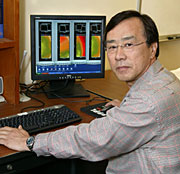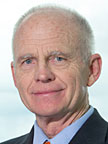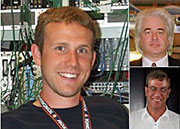| Research
|
The serene countryside of southeastern Idaho has been home and workplace to Dr. Harold McFarlane for more than 30 years. With decades of nuclear engineering experience to aid him, the newly appointed president of the American Nuclear Society (ANS) relishes his role in the future of nuclear energy. McFarlane is the Deputy Associate Laboratory Director of Nuclear Programs at DOE's Idaho National Laboratory. He also directs the Space Nuclear Systems and Technology Division, which oversees the radioisotope power systems program, whose main focus is radioisotope thermoelectric generators (RTGs). McFarlane's program assembles generators for NASA's solar system exploration probes. The INL space systems program works closely with the Center for Space Nuclear Research (CSNR), also located in Idaho. CSNR is developing possibilities of nuclear reactors in space and one day launching rockets from the moon, where less resistance and lower gravity could improve efficiency and speed of space exploration and travel. The center also researches the technology innovations that would enable humans to live in space. INL assembled its first RTG for the New Horizons mission to Pluto to expose the planet's well-hidden mysteries. More in-depth information on Pluto will help scientists understand the history and composition of our solar system. McFarlane initiated the transfer of the RTG assembly operations from Ohio to INL in 2004 and witnessed INL's first product launch to Pluto in early 2006. McFarlane's experience includes 20 years of fast reactor development and 12 years leading nuclear fuel cycle research explaining his excitement about the Department of Energy's Global Nuclear Energy Partnership. He has served as the Argonne National Laboratory-West site manager, assistant laboratory director for environment, safety and health and program manager for the Zero Power Physics Reactor. Submitted by DOE's Idaho National Laboratory |
|||||||||||||||||||||||||||
|
Check out the Office of Science's new Website.
|
PPPL collaboration yields
|
 |
|---|
|
Hyeon Park |
“The sawtooth instability derives its name from the pattern of the x-ray signal coming from the core of the plasma. The repetitive up and down (sawtooth) pattern of the X-ray signal is due to the relatively slow build up and rapid collapse of the central plasma pressure at regular intervals,” said PPPL physicist Hyeon Park.
In recent work was performed on the TEXTOR fusion device in Germany, two-dimensional pictures of microwaves emitted from core of the plasma showed that during the sawtooth collapse, heat from the center of the plasma flows outward via a small disturbance in the confining magnetic field. Park explained the importance of this for future fusion power plants.
“The sawtooth instability will cause helium produced in fusion reactions to be exhausted from the center of the plasma to its edge. The helium ash will hold 20% of the fusion energy produced, and in a fusion reactor, this energy will be the predominant source of plasma heating. Once it has imparted its energy to the bulk plasma, the helium must be swept out to the edge of the plasma and removed. Otherwise it will build up, cool the plasma, and the fusion reaction will stop. However, if the sawtooth instability is not properly controlled, the helium will be swept out prematurely. So it would really be great, if we had a ‘knob' on the fusion reactor to turn the instability on and off and to regulate its amplitude and frequency,” he said.
In addition to its importance in developing a magnetic fusion reactor, understanding the sawtooth oscillation will be highly beneficial for solar and interstellar physics which both involve magnetically-confined plasma phenomena.Submitted by DOE's
Princeton Plasma
Physics Laboratory



